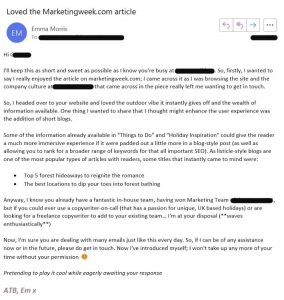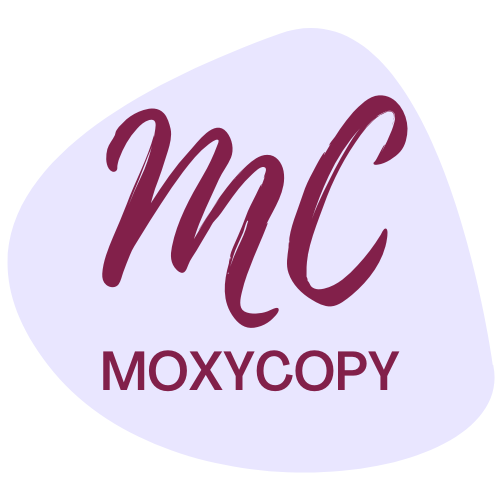That headline’s rather a bold statement, isn’t it? Can I really get you to fall in love with sending cold emails? I think so.
But first, how do you feel about sending cold emails? Many people think of the terrible generic, unsolicited emails we receive daily that are filtered straight into junk or quickly deleted before we get past the subject.
And, of course, why would you want to be responsible for sending those very same emails?
Nobody wants to be that person (well, I guess some people do, but maybe they just haven’t come across this post yet – feel free to share it with anyone that sends you an icky cold email).
That’s not the type of email I’m talking about. I’m talking about a “cold email” that will make the receiver feel like they are talking to a long-lost friend. The type of “cold email” that isn’t about making a sale; it’s about authentically trying to help someone solve a problem they have and build genuine relationships – now, that sounds less icky, doesn’t it?
So, here’s a rule from here on out. It’s no longer referred to as a cold email; let’s use an introduction or outreach email.
At the start of my copywriting journey, I remember other copywriters (or any business owner) would tell me there’s only so long you can live off referrals. Eventually, you will need to do some outreach to build a steady pipeline.
They would tell me what I needed to do, but they weren’t sharing how to do it well. So, I fell into a few email etiquette faux pas, and my first few introduction emails definitely came from a place of selling rather than problem-solving and relationship-building. Unsurprisingly, I rarely got a response; if I did, it wasn’t always polite.
Practice makes perfect
So, after much trial and error. I got better at writing introduction emails. I thought about what would get me to read an email from someone I didn’t know and especially what wouldn’t.
Even this morning, I received an email from a company asking me to forward their email to the person responsible for leadership and management training in my company. Yet one look at my website/socials/anything would have told them it’s just little old me here. There is no one to forward their email to (as if I would anyway!)
Anyway, back to the part you actually want to know about (btw did you skim to get the formula? It’s ok; I do the same thing if I’ve clicked on a blog for a particular reason.)
Let’s try again (so many tangents), anyway—the formula. The more I practised (and I mean, every single day), the more I noticed my response rates were going up, and they were much more polite, interested even.
So, I continued doing what I was doing, refining, optimising, and practising until I had the easy-to-follow formula I will share with you today. I have been using this formula for around six months now and can honestly say I receive a response rate of approximately 80%.
Of course, that’s not all sales, but just getting a response means something resonated with them and can help you stay top of mind next time they are looking for your product or service.
The formula
Now, when I say this is an easy-to-follow formula, it definitely is. However, the process of sending introduction emails that get results takes time and is not something you should do in bulk.
But, if you are willing to put in the time and effort, you will get results and fall in love with this form of marketing. So let’s get started.
#1 Research
The first thing to do is choose your prospect. This isn’t random; this is precise targeting of a person or company you want to work with. And this research is the most time-consuming part of the whole process.
Once you have chosen a prospect, find out who the correct contact is and their email address. LinkedIn, Google and other social media sites are great for this, or if you’re feeling brave, you could call the business directly and ask. But as I said, the internet is your best friend for this research, and some free sites can find email addresses for you.
As well as contact information, you will want to research an ice-breaker. This could be:
- A mutual contact (but never be dishonest about mutual connections)
- A recent article or blog the person has published
- An award they or their business has won
- Some new information about the company – a new product or service
- Even a social media post
Anything that will help make your email personal.
#2 Get the subject right
Just like headlines, your email subject is one of the most significant factors when someone decides whether to read your email or not. So, use your ice-breaker as a subject to build curiosity:
- Bob, loved your recent article in Forbes
- Jane, congratulations on business start-up of the year
- Steve suggested I introduce myself
You get the idea. It’s much more intriguing than 90% of the cold emails we receive.
#3 The three C’s – conversational, concise, convincing
Conversational. Please, please, please don’t open your email with “Dear sir/madam” or “To whom it may concern” or even worse, just “hi”.
Always include the person’s name; if you don’t know it, you need to do more research.
Similarly, at the end of your email, think of interesting ways to sign off rather than just “kind regards” or “many thanks”. You could use something like:
- Playing it cool but excitedly waiting for your response
- Have a great weekend – it’s so close I can almost hear the Prosecco pop
- Sending buckets of enthusiasm
- Greetings from sunny Scotland
It’s about finding something that matches your personality. And I know it throws out everything we have been taught about stuffy business writing, so it can feel scary to add character at first. Still, what’s the worst that can happen – they don’t reply? Ok, no biggie.
Another tip to keep your email conversational is to type fast. This not only stops you from overthinking the words you’re using but also helps convey enthusiasm (something your introduction email should ooze)
Concise. We all know how many emails we receive a day and how little time we have to read them, so get your message across concisely.
Compelling. Give them an irresistible reason to respond. Add value.
For example, when I contact a prospect about my email marketing service. I would have spent some time on their mailing list, and when I email them, I’ll share some advice about how they might improve their current email marketing. I’m providing value they can implement themselves while demonstrating my expertise.
The example
Now for the part you’re really here for! I don’t typically advocate using templates when writing, but this isn’t about copying what I write. It’s about using the framework, the formula and adapting it to your own.
And that’s what I do. I don’t write every introduction email from scratch – I follow this same framework every time and personalise it for my prospect.
I sent this exact email, and after further conversations, I landed nearly £5k in blog writing projects. So, here goes, prepare to fall in love…

As you can see, it’s personal, conversational, concise, compelling and adds value that the business can use even if they decide they don’t need a copywriter at this time.
It’s the complete opposite of what we think of when sending a cold email.
So, what do you think? Have I convinced you to fall in love with cold emails?
I’d love you to let me know in the comments.
As a content and copywriter, helping businesses attract and nurture their ideal clients to grow their sales lights me up. Drop me a message today if you need help identifying your perfect client, perfecting your messaging, or marketing your services.
You can also download my FREE guide to make SEO Easy, a handy desktop guide packed with quick and easy tips to get your business found online.
Or
If you’re stuck with where to start with your social media or blogs, I send a FREE email every Sunday with 7 content ideas for the week ahead to help you get those creative juices flowing. You can sign up here.

